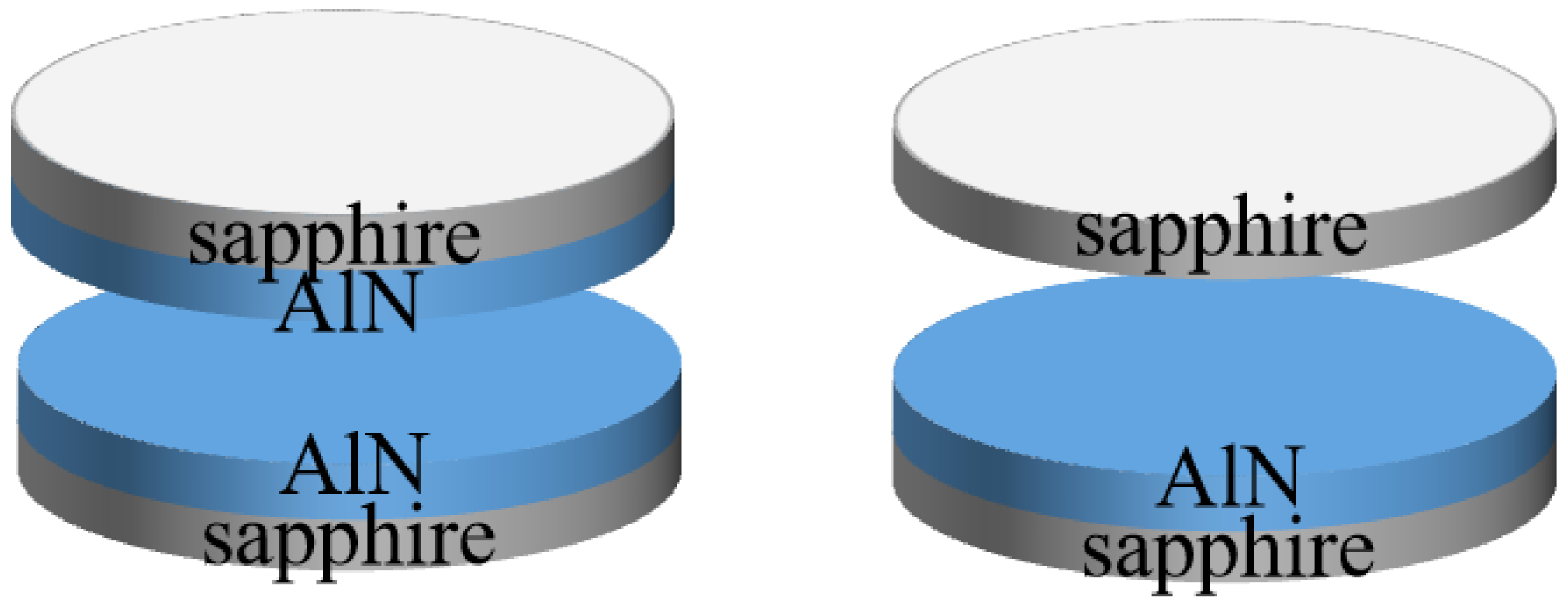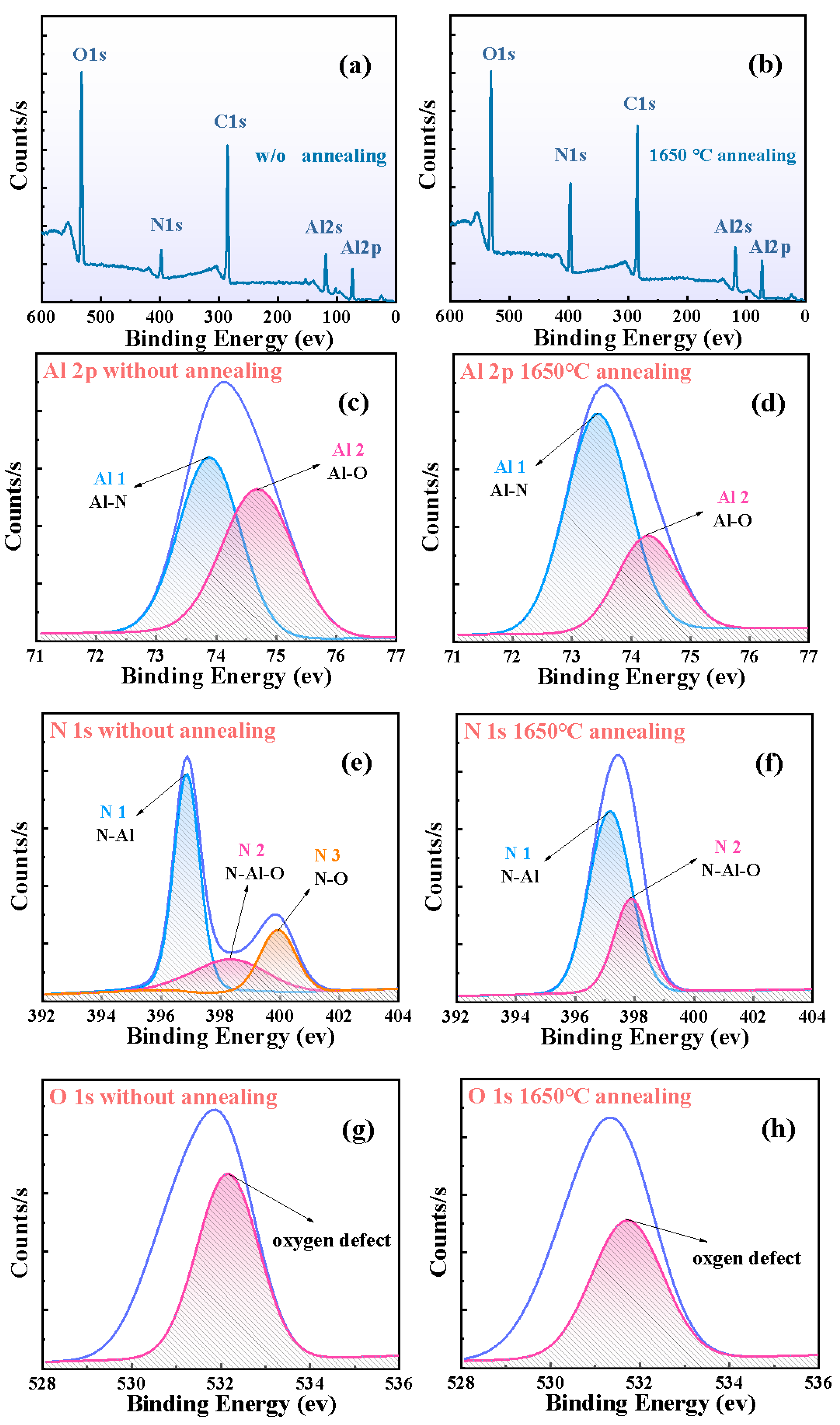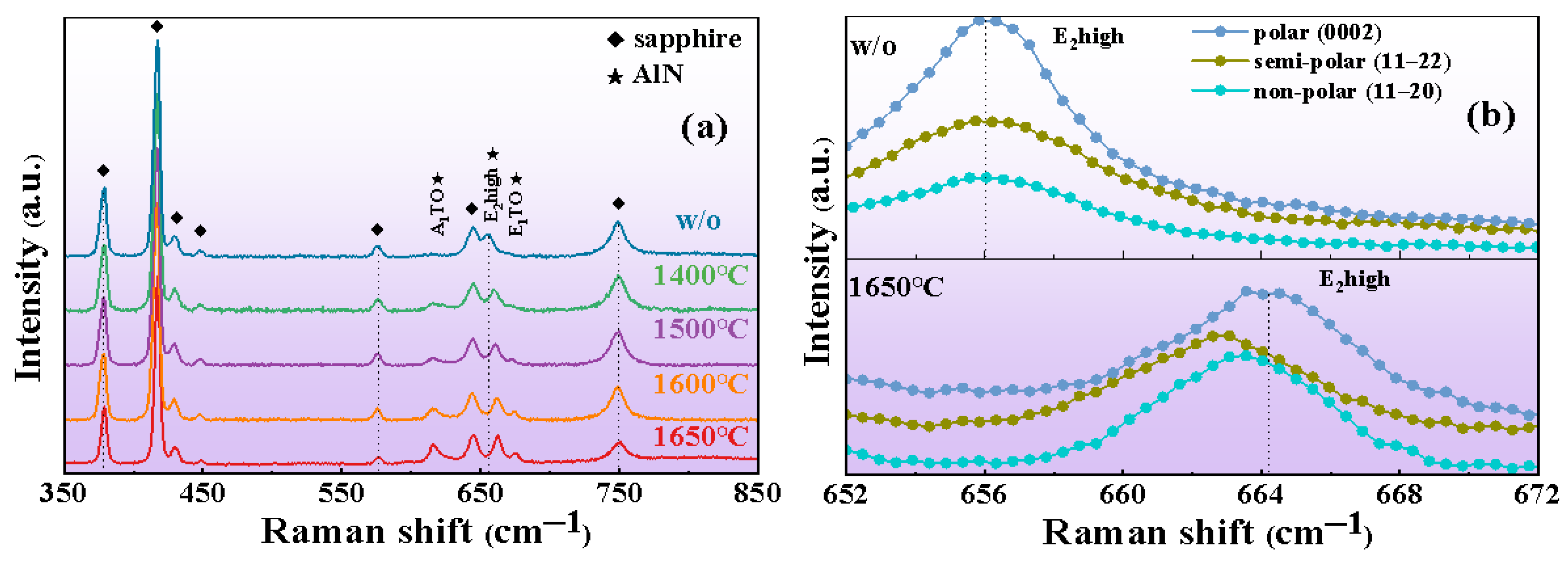Improvement of Crystal Quality of AlN Films with Different Polarities by Annealing at High Temperature
Abstract
:1. Introduction
2. Materials and Methods
3. Results and Discussion
4. Conclusions
Author Contributions
Funding
Institutional Review Board Statement
Informed Consent Statement
Data Availability Statement
Conflicts of Interest
References
- Mukai, T. Recent progress in group-III nitride light-emitting diodes. IEEE J. Sel. Top. Quantum Electron. 2002, 8, 264–270. [Google Scholar] [CrossRef]
- Kneissl, M.; Rass, J. III-Nitride Ultraviolet Emitters: Technology and Applications; Springer: Berlin/Heidelberg, Germany, 2016; Volume 227. [Google Scholar]
- Strite, S.; Morkoç, H. GaN, AlN, and InN: A review. J. Vac. Sci. Technol. B Microelectron. Nanometer Struct. 1992, 10, 1237–1266. [Google Scholar] [CrossRef]
- Mohammad, S.N.; Morkoç, H. Progress and prospects of group-III nitride semiconductors. Prog. Quantum Electron. 1996, 20, 361–525. [Google Scholar] [CrossRef]
- Yim, W.; Stofko, E.; Zanzucchi, P.; Pankove, J.; Ettenberg, M.; Gilbert, S. Epitaxially Grown AlN and its Optical Band Gap. J. Appl. Phys. 1973, 44, 292–296. [Google Scholar] [CrossRef]
- Li, J.; Nam, K.; Nakarmi, M.; Lin, J.-Y.; Jiang, H.; Carrier, P.; Wei, S.-H. Band structure and fundamental optical transitions in wurtzite AlN. Appl. Phys. Lett. 2004, 83, 5163–5165. [Google Scholar] [CrossRef] [Green Version]
- Goldberg, Y.; Levinshtein, M.; Rumyantsev, S. (Eds.) Properties of Advanced Semiconductor Materials: GaN, AIN, InN, BN, SiC, SiGe; SciTech Book News; Wiley-Interscience: Hoboken, NJ, USA, 2001; Volume 25, pp. 93–146. [Google Scholar]
- Sun, M.; Li, J.; Zhang, J.; Sun, W. The fabrication of AlN by hydride vapor phase epitaxy. J. Semicond. 2019, 40, 121803. [Google Scholar] [CrossRef]
- Jeschke, J.; Martens, M.; Knauer, A.; Kueller, V.; Zeimer, U.; Netzel, C.; Kuhn, C.; Krueger, F.; Reich, C.; Wernicke, T.; et al. UV-C Lasing from AlGaN Multiple Quantum Wells on Different Types of AlN/Sapphire Templates. IEEE Photonics Technol. Lett. 2015, 27, 1969–1972. [Google Scholar] [CrossRef]
- Wu, Z.; Yan, J.; Guo, Y.; Zhang, L.; Lu, Y.; Wei, X.; Wang, J.; Li, J. Study of the morphology evolution of AlN grown on nano-patterned sapphire substrate. J. Semicond. 2019, 40, 122803. [Google Scholar] [CrossRef]
- Zhang, B.; Egawa, T.; Ishikawa, H.; Liu, Y.; Jimbo, T. High-Bright InGaN Multiple-Quantum-Well Blue Light-Emitting Diodes on Si (111) Using AlN/GaN Multilayers with a Thin AlN/AlGaN Buffer Layer. Jpn. J. Appl. Phys. 2003, 42, L226–L228. [Google Scholar] [CrossRef]
- Kneissl, M.; Kolbe, T.; Chua, C.; Kueller, V.; Lobo, N.; Stellmach, J.; Knauer, A.; Rodriguez, H.; Einfeldt, S.; Yang, Z.; et al. Advances in group III-nitride-based deep UV light-emitting diode technology. Semicond. Sci. Technol. 2010, 26, 014036. [Google Scholar] [CrossRef]
- Deguchi, T.; Sekiguchi, K.; Nakamura, A.; Sota, T.; Matsuo, R.; Chichibu, S.; Nakamura, S. Quantum-Confined Stark Effect in an AlGaN/GaN/AlGaN Single Quantum Well Structure. Jpn. J. Appl. Phys. 1999, 38, L914–L916. [Google Scholar] [CrossRef]
- Craven, M.; Lim, S.; Wu, F.; Speck, J.; Denbaars, S. Structural characterization of nonpolar (110) a-plane GaN thin films grown on (102) r-plane sapphire. Appl. Phys. Lett. 2002, 81, 469–471. [Google Scholar] [CrossRef]
- Smorchkova, I.; Elsass, C.; Ibbetson, J.; Vetury, R.; Heying, B.; Fini, P.; Haus, E.; Denbaars, S.; Speck, J.; Mishra, U.K. Polarization-induced charge and electron mobility in AlGaN/GaN heterostructures grown by plasma-assisted molecular-beam epitaxy. J. Appl. Phys. 1999, 86, 4520–4526. [Google Scholar] [CrossRef]
- Yoshizumi, Y.; Adachi, M.; Enya, Y.; Kyono, T.; Tokuyama, S.; Sumitomo, T.; Akita, K.; Ikegami, T.; Ueno, M.; Katayama, K.; et al. Continuous-Wave Operation of 520 nm Green InGaN-Based Laser Diodes on Semi-Polar {2021} GaN Substrates. Appl. Phys. Express 2009, 2, 092101. [Google Scholar] [CrossRef]
- Hwang, S.M.; Seo, Y.G.; Baik, K.; Cho, I.-S.; Baek, J.-H.; Jung, S.; Kim, T.; Cho, M. Demonstration of nonpolar a-plane InGaN/GaN light emitting diode on r-plane sapphire substrate. Appl. Phys. Lett. 2009, 95, 071101. [Google Scholar] [CrossRef]
- Pristovsek, M.; Frentrup, M.; Han, Y.; Humphreys, C.J. Optimizing GaN (11–22) hetero-epitaxial templates grown on (10–10) sapphire. Phys. Status Solidi 2016, 253, 61–66. [Google Scholar] [CrossRef] [Green Version]
- Rajpalke, M.K.; Roul, B.; Kumar, M.; Bhat, T.N.; Sinha, N.; Krupanidhi, S.B. Structural and optical properties of nonpolar (11−20) a-plane GaN grown on (1−102) r-plane sapphire substrate by plasma-assisted molecular beam epitaxy. Scr. Mater. 2011, 65, 33–36. [Google Scholar] [CrossRef]
- Miyake, H.; Lin, C.H.; Tokoro, K.; Hiramatsu, K. Preparation of high-quality AlN on sapphire by high-temperature face-to-face annealing. J. Cryst. Growth 2016, 456, 155–159. [Google Scholar] [CrossRef] [Green Version]
- Wang, H.; Chen, C.; Gong, Z.; Zhang, J.; Gaevski, M.; Su, M.; Yang, J.; Khan, M.A. Anisotropic structural characteristics of (110) GaN templates and coalesced epitaxial lateral overgrown films deposited on (102) sapphire. Appl. Phys. Lett. 2004, 84, 499–501. [Google Scholar] [CrossRef]
- Sharma, N.; Ilango, S.; Dash, S.; Tyagi, A.K. X-ray photoelectron spectroscopy studies on AlN thin films grown by ion beam sputtering in reactive assistance of N+/N2+ ions: Substrate temperature induced compositional variations. Thin Solid Film. 2017, 636, 626–633. [Google Scholar] [CrossRef]
- Youngman, R.A.; Harris, J.H. Luminescence Studies of Oxygen-Related Defects in Aluminum Nitride. J. Am. Ceram. Soc. 1990, 73, 3238–3246. [Google Scholar] [CrossRef]
- Harris, J.; Youngman, R.; Teller, R. On the Nature of the Oxygen Related Defect in Aluminum Nitride. J. Mater. Res. 1990, 5, 1763–1773. [Google Scholar] [CrossRef]
- Westwood, A.D.; Youngman, R.A.; McCartney, M.R.; Cormack, A.N.; Notis, M.R. Oxygen incorporation in aluminum nitride via extended defects: Part II. Structure of curved inversion domain boundaries and defect formation. J. Mater. Res. 1995, 10, 1287–1300. [Google Scholar] [CrossRef]
- Rosenberger, L.; Baird, R.; McCullen, E.; Auner, G.; Shreve, G. XPS Analysis of Aluminum Nitride Films Deposited by Plasma Source Molecular Beam Epitaxy. Surf. Interface Anal. 2008, 40, 1254–1261. [Google Scholar] [CrossRef]
- Heinke, H.; Kirchner, V.; Einfeldt, S.; Hommel, D. X-ray diffraction analysis of the defect structure in epitaxial GaN. Appl. Phys. Lett. 2000, 77, 2145–2147. [Google Scholar] [CrossRef]
- Holtz, M.; Nikishin, S.; Faleev, N.; Temkin, H.; Zollner, S. Vibrational Properties of AlN Grown on (111)-Oriented Silicon. Phys. Rev. B 2001, 63, 125313. [Google Scholar]
- Yang, S.; Miyagawa, R.; Miyake, H.; Hiramatsu, K.; Harima, H. Raman Scattering Spectroscopy of Residual Stresses in Epitaxial AlN Films. Appl. Phys. Express 2011, 4, 031001. [Google Scholar] [CrossRef]
- Claudel, A.; Fellmann, V.; Gélard, I.; Coudurier, N.; Sauvage, D.; Balaji, M.; Blanquet, E.; Boichot, R.; Beutier, G.; Coindeau, S.; et al. Influence of the V/III ratio in the gas phase on thin epitaxial AlN layers grown on (0001) sapphire by high temperature hydride vapor phase epitaxy. Thin Solid Films 2014, 573, 140–147. [Google Scholar] [CrossRef]
- Jain, S.C.; Harker, A.H.; Cowley, R.A. Misfit strain and misfit dislocations in lattice mismatched epitaxial layers and other systems. Philos. Mag. A 1997, 75, 1461–1515. [Google Scholar] [CrossRef]
- Liu, M.S.; Nugent, K.W.; Prawer, S.; Bursill, L.A.; Peng, J.L.; Tong, Y.Z.; Jewsbury, P. Micro-Raman Scattering Properties of Highly Oriented AlN Films. Int. J. Mod. Phys. B 1998, 12, 1963–1974. [Google Scholar] [CrossRef]
- Wagner, J.-M.; Bechstedt, F. Properties of strained wurtzite GaN and AlN: Ab initio studies. Phys. Rev. B 2002, 66, 115202. [Google Scholar] [CrossRef]






| Direction | W/O | 1400 °C HTA | 1500 °C HTA | 1600 °C HTA | 1650 °C HTA |
|---|---|---|---|---|---|
| [0001] | 111 | 73 | 57 | 37 | 26 |
| [1−100] | 159 | 87 | 60 | 38 | 27 |
| Sample | Al (at. %) | N (at. %) | C (at. %) | O (at. %) |
|---|---|---|---|---|
| Polar | 15.68 | 8.41 | 49.88 | 26.03 |
| Semi-polar | 15.62 | 5.49 | 49.93 | 28.96 |
| Non-polar | 15.43 | 4.93 | 50.03 | 29.61 |
| Sample | Al (at. %) | N (at. %) | C (at. %) | O (at. %) |
|---|---|---|---|---|
| Polar | 25.29 | 20.03 | 40.19 | 14.49 |
| Semi-polar | 16.73 | 17.19 | 42.37 | 23.81 |
| Non-polar | 24.29 | 17.22 | 40.85 | 17.64 |
Publisher’s Note: MDPI stays neutral with regard to jurisdictional claims in published maps and institutional affiliations. |
© 2022 by the authors. Licensee MDPI, Basel, Switzerland. This article is an open access article distributed under the terms and conditions of the Creative Commons Attribution (CC BY) license (https://creativecommons.org/licenses/by/4.0/).
Share and Cite
Yue, Y.; Sun, M.; Chen, J.; Yan, X.; He, Z.; Zhang, J.; Sun, W. Improvement of Crystal Quality of AlN Films with Different Polarities by Annealing at High Temperature. Micromachines 2022, 13, 129. https://doi.org/10.3390/mi13010129
Yue Y, Sun M, Chen J, Yan X, He Z, Zhang J, Sun W. Improvement of Crystal Quality of AlN Films with Different Polarities by Annealing at High Temperature. Micromachines. 2022; 13(1):129. https://doi.org/10.3390/mi13010129
Chicago/Turabian StyleYue, Yang, Maosong Sun, Jie Chen, Xuejun Yan, Zhuokun He, Jicai Zhang, and Wenhong Sun. 2022. "Improvement of Crystal Quality of AlN Films with Different Polarities by Annealing at High Temperature" Micromachines 13, no. 1: 129. https://doi.org/10.3390/mi13010129
APA StyleYue, Y., Sun, M., Chen, J., Yan, X., He, Z., Zhang, J., & Sun, W. (2022). Improvement of Crystal Quality of AlN Films with Different Polarities by Annealing at High Temperature. Micromachines, 13(1), 129. https://doi.org/10.3390/mi13010129





